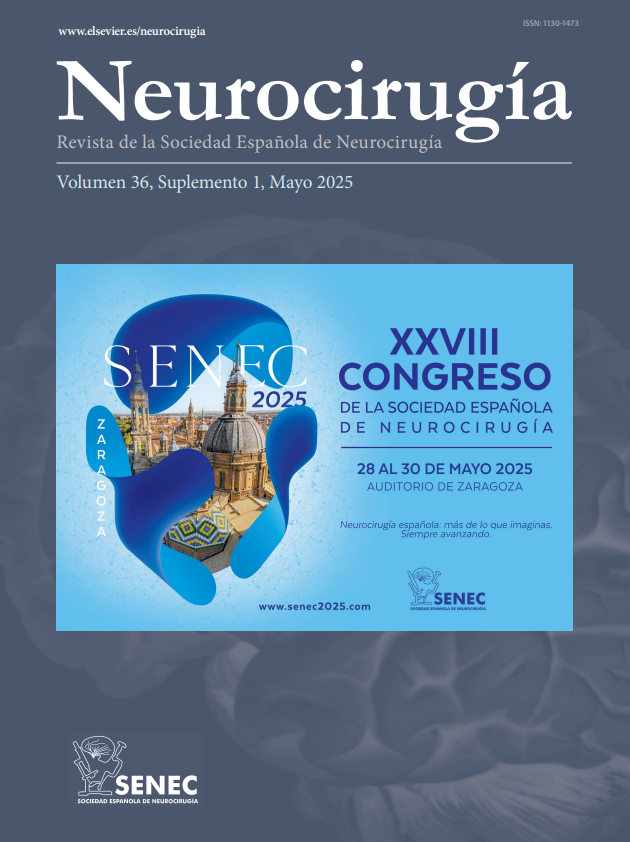Purpose: In the surgical management of spinal tumours, haemilaminectomy is frequently the preferred approach due to its minimal invasive nature and the ability to preserve stability. However, the repair of the dura mater defect is technically very difficult and a challenging problem for neurosurgeons because of the high incidence of complications related to postoperative cerebrospinal fluid (CSF) leakage. This study presents a novel haemoclip-assisted technique that has been developed for the purpose of providing safe and rapid dura repair in spinal tumour surgery involving haemilaminectomy.
Material and Methods: In 12 patients who underwent haemilaminectomy for spinal intradural extramedullary tumours between 2023 and 2024, dura mater defects were repaired with haemoclips. The technique is to present the results of cases in which the dura edges were closed with non-penetrating haemoclips. The results were evaluated in terms of dura repair time, postoperative complications and presence of CSF leakage.
Results: The mean dural repair time was found to be significantly shorter when compared to conventional suture methods. Postoperative cerebrospinal fluid leakage and related complications were not observed in any patient. The technique significantly facilitated surgical practice, especially in the haemilaminectomy window, which provides a limited field of view. Furthermore, the absence of artefacts in magnetic resonance imaging (MRI) appears to be a significant additional criterion in patient follow-up.
Conclusion: Haemoclip-assisted dura repair is a safe, fast and practical alternative for spinal tumour surgery with haemilaminectomy. The technique has the potential to reduce complication rates by facilitating dura repair.
Propósito: En el tratamiento quirúrgico de los tumores espinales, la hemilaminectomía suele ser el abordaje preferido debido a su carácter mínimamente invasivo y a su capacidad para preservar la estabilidad. Sin embargo, la reparación del defecto de la duramadre es técnicamente muy difícil y supone un gran desafío para los neurocirujanos, ya que la fuga postoperatoria de líquido cefalorraquídeo (LCR) es muy habitual. Este estudio presenta una técnica asistida por hemoclip desarrollada para proporcionar una reparación segura y rápida de la duramadre en cirugías de tumores espinales con hemilaminectomía.
Material y métodos: Entre 2023 y 2024, se repararon los defectos de la duramadre con hemoclips en 12 pacientes sometidos a hemilaminectomía por tumores extramedulares intradurales espinales. La técnica consiste en presentar los resultados de los casos en los que los bordes de la duramadre se cerraron con hemoclips no penetrantes. Los resultados se evaluaron en términos de tiempo quirúrgico, tiempo de reparación de la duramadre, complicaciones posoperatorias y presencia de fuga de líquido cefalorraquídeo (LCR).
Resultados: Se observó que el tiempo medio de reparación dural era significativamente menor en comparación con los métodos de sutura convencionales. No se produjeron fugas postoperatorias de líquido cefalorraquídeo ni complicaciones relacionadas en ningún paciente. La técnica facilitó notablemente la práctica quirúrgica, especialmente en la ventana de hemilaminectomía, que ofrece un campo de visión reducido. Además, la ausencia de artefactos en la resonancia magnética (RM) parece ser un criterio de seguimiento significativo para los pacientes.
Conclusión: La reparación de la duramadre asistida por hemoclip es una alternativa segura, rápida y práctica para la cirugía de tumores espinales con hemilaminectomía. Esta técnica puede reducir las tasas de complicaciones al facilitar la reparación de la duramadre.
Article

If it is the first time you have accessed you can obtain your credentials by contacting Elsevier Spain in suscripciones@elsevier.com or by calling our Customer Service at902 88 87 40 if you are calling from Spain or at +34 932 418 800 (from 9 to 18h., GMT + 1) if you are calling outside of Spain.
If you already have your login data, please click here .
If you have forgotten your password you can you can recover it by clicking here and selecting the option ¿I have forgotten my password¿.






